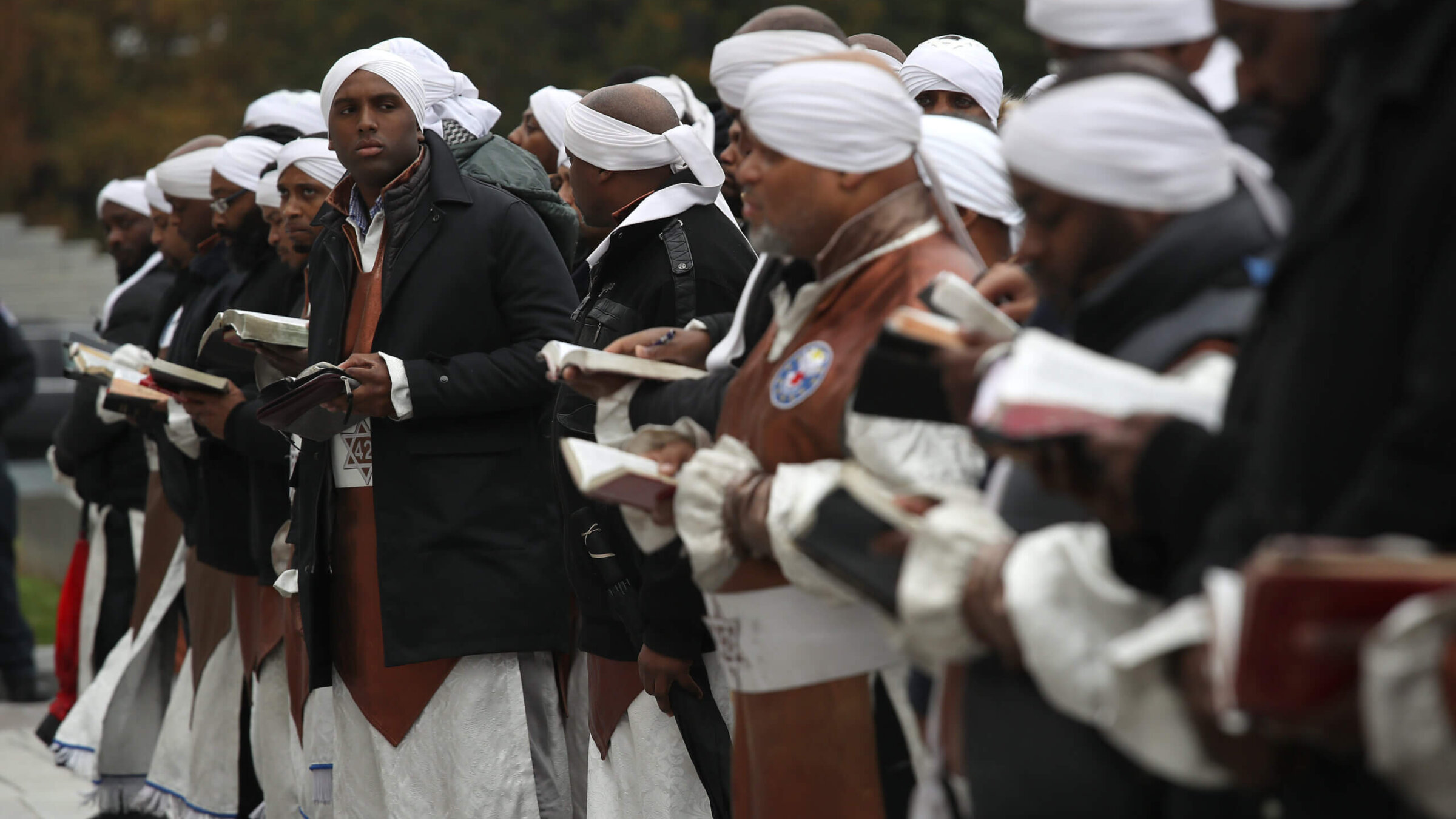I’m a Jew of color. Stop conflating us with Hebrew Israelites
Jews of color can set the record straight on the meaningful historical differences between themselves and Hebrew Israelites

Members of a Hebrew Israelite group demonstrate outside the U.S. Capitol on November 13, 2018 in Washington, D.C. Photo by Win McNamee/Getty Images
The last few months of 2022 were a chaotic and painful time for many Jews of color.
Jews of all backgrounds watched in horror as thousands of radical Hebrew Israelites marched in formation chanting that they “are the real Jews” outside of the Barclays Center, where the Brooklyn Nets play basketball.
For many Jews of color, the reemergence of this brand of antisemitism espoused by radical camps of the Hebrew Israelite movement has invited increased suspicion and bigotry toward those of us who exist in the intersection of the Jewish and Black, Latinx and Native communities. (I say “radical” to distinguish more extremist groups from Hebrew Israelites at large, who are closer to mainstream Judaism and do not espouse hateful beliefs, which I will explain in more detail below.)
These issues were compounded with concerns over erasure when, during an appearance on The Breakfast Club speaking about this incident, Anti-Defamation League CEO Jonathan Greenblatt conflated Black Jews with Hebrew Israelites, stating: “There is a range of (Jewish) practice and observance. There are plenty of Black Jews, who go to what you might call a traditional synagogue, and there are other communities like the Black Hebrew Israelites.”
One might wonder why this conflation is so problematic, or how it contributes to bigotry towards Jews of color. For many Jews like myself, being a Jew of color in America has meant having to constantly justify the legitimacy of our Jewishness. Far too many Americans believe that a Jew must “look white,” or like a “typical” Ashkenazi person.
Jews of color have long labored within the Jewish community to make these spaces more inclusive by insisting on Judaism’s racial neutrality. When radical Hebrew Israelites attempt to enter these same spaces with a Christian theology that explicitly embraces a racialized (Black vs. white) paradigm, while themselves identifying as the “real” Black and Brown Jews, it undermines our work and our very identities.
When leaders of the Jewish community broadly conflate Jews of color with Hebrew Israelites, it confirms our fear that radical Hebrew Israelites are not only contributing to the increase in antisemitism (which also affects us), but also to the erasure of Jews of color as an integral part of the American Jewish community.
It’s long past time for the American Jewish communal leadership to allow for Jewish voices of color to set the record straight on the meaningful differences and the historical relationship between JOC and the Hebrew Israelite movement. We can’t allow extremists to hijack these historical narratives.
Being of Caribbean Jewish descent, I am intimately familiar with the hard-fought scholastic debates surrounding the taboo relationships between Sephardic Jews and people of color in the Caribbean, the legitimacy and historicity of Igbo Israelite identity and the legacy of Jewish communities in the Songhai Empire in Mali, histories that many associate with the origins of Jews of color in the Americas. While these complex historical and religious experiences also played a key role in producing the Hebrew Israelite movement, these groups should not be confused or conflated.
Jews of color have been members of the Jewish communities of the Caribbean and North America since their inception. Documentation in the form of Jewish marriage certificates and gravestones date back to the 1720s. Jews who trace their origins to both Africa and the Americas overcame norms of racial segregation and created legacies that are the heritage of thousands of Jews across the U.S. and the Caribbean. They are rabbis in your local synagogue. They are members of the local chapter of the Jewish federation. They attend Hebrew day schools with your kids.
Hebrew Israelites have a separate history. An early Israelite community, consisting of formerly enslaved persons, was established in 1810. Within two centuries, hundreds of communities emerged across the U.S. founded by formerly enslaved African Americans as well as new immigrants from the Caribbean.
Some Israelite congregations were almost identical to pentecostal churches, while others adopted Jewish practices and opened their doors to ”Israelites” of Sephardi and Ashkenazi backgrounds. In the 1970s, a radical offshoot of the movement known as “1West” would extend its Israelite identification and membership to all Latinx and Indigenous Americans, with antisemitism playing a central role in its propagation. 1West, with their explicit belief that the Jewish world has usurped the Hebrew identity of Black, Latinx and Native Americans, has come to dominate the headlines with their hateful rhetoric.
Many assert that the entire Hebrew Israelite movement is rooted in the appropriation of Jewish identity and practice, like those who blow shofars and wear tzitzit today at evangelical churches. That theory may be appropriate when speaking about the more explicitly Christian communities founded by men whose Israelite identity emerged in the context of ecstatic visions. It’s far too simplistic, however, to apply this same framework to Hebrew Israelite synagogues and communities founded by people with oral histories of Jewish/Israelite descent and/or practice — in no small part from the Caribbean. The work of scholars Bruce Haynes and Walter Isaac (recently interviewed by the Forward) painstakingly records this.
Within this historical framework, it becomes apparent that the vast differences between various communities collectively referred to as “Hebrew Israelite” are the result of varying ideas and origins. As a result, scholars like Haynes have concluded that the term itself is a major source of confusion. One thing is certain: In contradistinction to JOC, Hebrew Israelites organized either completely separate from Jewish communities or on its margins.
As a result, in the eyes of many Jews, including many prominent JOC, if Hebrew Israelites who were born as Christians never converted, never joined a Jewish community, how is this not appropriation?
The lines that divide were not, and are not always so clearly demarcated. Both Willy “the Lion” Smith and Thomas LaRue, pioneers in mainstreaming the existence and contributions of American JOC in the 1920s and 1940s, found comfort and community in the halachic Judaism-based environment of Caribbean and African American Hebrew Israelite Synagogues, which included Ashkenazi and Sephardi Jews in their pews.
Likewise, many Hebrew Israelite leaders, including Rudolph Windsor, Eli Aronoff and Capers Funnye, and/or their descendants went through halachic conversions in order to fully participate in Jewish life, and to be part of institutions where JOC had long labored to be included.
In an era of U.S. history defined by Jim Crow and redlining, Hebrew Israelites with an affinity to Judaism and JOC who felt marginalized in the Jewish spaces they called home sometimes found common cause in the pursuit of spiritual community. Organizations like Hatzaad HaRishon sought innovative ways to respect both the dignity of those seeking to reconnect to Israelite identity and the Jewish people’s standards of communal membership.
What changed? Well, a lot. The collapse of the long-hailed Black-Jewish alliance of the civil rights era gave way to ethnic tensions that put significant pressure on JOC and Judaism-oriented Hebrew Israelite communities to pick sides.
Anti-Blackness by some in the Jewish community has allowed the erasure of JOC voices and contributions, while antisemitism by some in communities of color has allowed for radical Hebrew Israelite organizations to gain followers and silence Hebrew Israelites who continue to seek a path towards reconciliation and commonality with the Jewish community in general, and with JOC in particular.
Neither JOC or Hebrew Israelites will benefit from glossing over our differences. The histories, experiences and beliefs of JOC and Hebrew Israelites are different, often vastly so. Greenblatt’s mischaracterization on The Breakfast Club provides a timely reminder of just how important these distinctions are. We cannot bridge a divide if we don’t acknowledge it exists.
In the wake of increased discussions about Crypto-Jewish identity, the reemergence of “lost” Israelite tribes, and the role that the concept of race has often played in a highly racialized America in Jewish identity, our generation must come up with better means to negotiate these differences and deepen understanding. Otherwise, we are merely providing fodder to those who seek to use division and lack of knowledge to incite hatred.
To contact the author, email [email protected]
A message from our Publisher & CEO Rachel Fishman Feddersen

I hope you appreciated this article. Before you go, I’d like to ask you to please support the Forward’s award-winning, nonprofit journalism so that we can be prepared for whatever news 2025 brings.
At a time when other newsrooms are closing or cutting back, the Forward has removed its paywall and invested additional resources to report on the ground from Israel and around the U.S. on the impact of the war, rising antisemitism and polarized discourse.
Readers like you make it all possible. Support our work by becoming a Forward Member and connect with our journalism and your community.
— Rachel Fishman Feddersen, Publisher and CEO





























